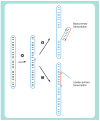Origin of hepatitis delta virus
- PMID: 20210550
- PMCID: PMC2852136
- DOI: 10.2217/fmb.10.15
Origin of hepatitis delta virus
Abstract
This article addresses some of the questions relating to how hepatitis delta virus (HDV), an agent so far unique in the animal world, might have arisen. HDV was discovered in patients infected with hepatitis B virus (HBV). It generally makes HBV infections more damaging to the liver. It is a subviral satellite agent that depends upon HBV envelope proteins for its assembly and ability to infect new cells. In other aspects of replication, HDV is both independent of and very different from HBV. In addition, the small single-stranded circular RNA genome of HDV, and its mechanism of replication, demonstrate an increasing number of similarities to the viroids - a large family of helper-independent subviral agents that cause pathogenesis in plants.
Figures


Similar articles
-
An update on HDV: virology, pathogenesis and treatment.Antivir Ther. 2013;18(3 Pt B):541-8. doi: 10.3851/IMP2598. Epub 2013 Jun 21. Antivir Ther. 2013. PMID: 23792471 Review.
-
Pathogenesis by subviral agents: viroids and hepatitis delta virus.Curr Opin Virol. 2016 Apr;17:87-94. doi: 10.1016/j.coviro.2016.01.022. Epub 2016 Feb 18. Curr Opin Virol. 2016. PMID: 26897654 Review.
-
Hepatitis delta virus (HDV) infection and disease.Ric Clin Lab. 1989 Jan-Mar;19(1):11-26. doi: 10.1007/BF02871788. Ric Clin Lab. 1989. PMID: 2669109 Review.
-
Virological and clinical characteristics of hepatitis delta virus in South Asia.Virol J. 2011 Jun 20;8:312. doi: 10.1186/1743-422X-8-312. Virol J. 2011. PMID: 21689416 Free PMC article.
-
Hepatitis delta virus infection: open issues.Dig Liver Dis. 2011 Jan;43 Suppl 1:S19-24. doi: 10.1016/S1590-8658(10)60688-3. Dig Liver Dis. 2011. PMID: 21195367 Review.
Cited by
-
A scenario for the emergence of protoviroids in the RNA world and for their further evolution into viroids and viroid-like RNAs by modular recombinations and mutations.Virus Evol. 2022 Jan 15;8(1):veab107. doi: 10.1093/ve/veab107. eCollection 2022. Virus Evol. 2022. PMID: 35223083 Free PMC article. Review.
-
Molecular and clinical aspects of hepatitis D virus infections.World J Virol. 2012 Jun 12;1(3):71-8. doi: 10.5501/wjv.v1.i3.71. World J Virol. 2012. PMID: 24175212 Free PMC article.
-
Characterization of hepatitis delta virus in sub-Saharan Africa.J Clin Microbiol. 2014 May;52(5):1629-36. doi: 10.1128/JCM.02297-13. Epub 2014 Mar 5. J Clin Microbiol. 2014. PMID: 24599979 Free PMC article.
-
Arginine-rich motifs are not required for hepatitis delta virus RNA binding activity of the hepatitis delta antigen.J Virol. 2013 Aug;87(15):8665-74. doi: 10.1128/JVI.00929-13. Epub 2013 Jun 5. J Virol. 2013. PMID: 23740973 Free PMC article.
-
Viroids and the Origin of Life.Int J Mol Sci. 2021 Mar 28;22(7):3476. doi: 10.3390/ijms22073476. Int J Mol Sci. 2021. PMID: 33800543 Free PMC article. Review.
References
Bibliography
-
- Rizzetto M, Canese MG, Gerin JL, London WT, Sly DL, Purcell RH. Transmission of the hepatitis B virus-associated δ antigen to chimpanzees. J Infect Dis. 1980;141:590–602. - PubMed
-
- Taylor JM, Farci P, Purcell RH. Hepatitis D (δ) virus. In: Knipe DM, editor. Fields Virology. Lippincott Williams & Wilkins; PA, USA: 2007. pp. 3031–3046.
-
-
Deny P. Hepatitis δ virus genetic variability: from genotypes I, II, III to eight major clades. In: Casey JL, editor. Hepatitis δ Virus. Springer; Heidelberg, Germany: 2006. pp. 151–171. ▪▪ Defines the many clades of hepatitis δ virus HDV.
-
Website
-
- Subviral RNA Database. http://subviral.med.uottawa.ca.
Publication types
MeSH terms
Grants and funding
LinkOut - more resources
Full Text Sources
Other Literature Sources
Medical
